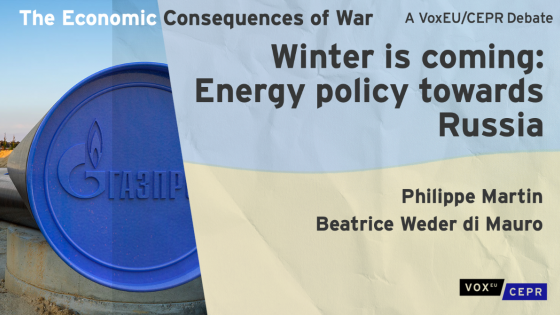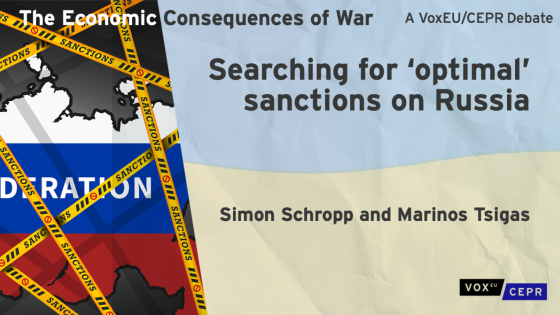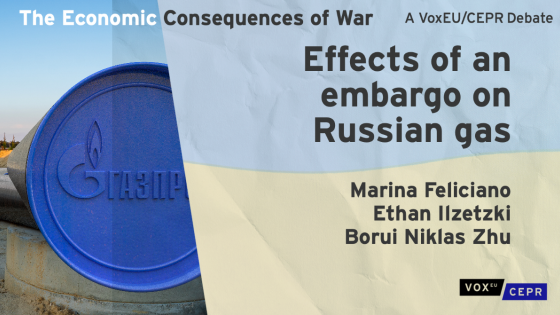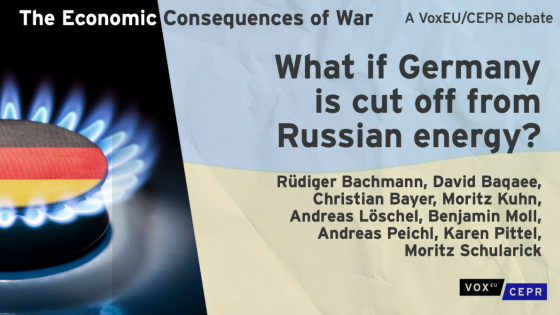Editors' note: This column is part of the Vox debate on the economic consequences of war.
In the heat of summer, with most of Europeans thinking about flying away to distant beaches, winter may seem far away. But it will be here soon, and it may become a winter of discontent, with European unity severely tested, again.
So far, the EU’s response to the Russian invasion of Ukraine has been common and strong on general sanctions but weak and divided on energy. This partly reflects differential dependence on Russian gas across countries and the desire to build ‘own’ buffers and storages. It does not bode well for energy sharing and solidarity, should the coming winter be tough. And, of course, Russia has every incentive to increase the pain and to play countries against each other. The uncertainty about the North Stream One restart after the summer inspection may just be a foretaste of the coming strategic games.
Results of policies so far
So far, energy policy has aimed at securing quantities, at all costs. As a result, EU gas storages stand at about 65%, which is a high filling rate at this time of the year. However, total underground storage capacity is about 100 billion cubic metres while consumption was around 400 billion cubic metres in 2020 (European Commission 2022). Storage filling rates are public information, and it is unlikely that Putin is ignoring them in planning his deliveries.
In the meantime, Russian federal budget revenues were up by 34% in the first four months of 2022 compared to the same period of 2021 (Bank of Finland 2022), with the revenue rise driven entirely by high prices for oil and gas. This suggests that sanctions have not been very successful in achieving their primary objective of increasing the cost for Russia of waging this war and making it more difficult to finance it. At the same time, the spike in energy prices has been hurting Europeans since it is a key driver of inflation. Energy prices are still climbing as Russia has stopped gas deliveries claiming technical difficulties or non-compliance with payments in rubles.
Several avenues have been suggested to make sanctions both more effective and less costly for European households and firms: an embargo, tariffs, and price caps.
A future embargo on oil
An embargo on Russian energy products (oil and/or gas) has been subject to a fierce debate with differing estimates of the growth impact, ranging from comparable to the Covid-19 shock to considerably smaller in countries less dependent on Russian gas (e.g. Bachmann et al. 2022, Baqaee et al. 2022).
On 30 May 2022, the EU decided to impose an embargo on imports of Russian oil and petroleum products, but it will only take effect in six months. This announcement led to an increase in the price of oil (by around 5%), but it had already been preceded by an upward trend since mid-May when the embargo became more likely. The expectation of the announcement therefore generated a windfall for Russia. For gas, since the beginning of the war, the expectation of possible future sanctions was also behind the price hikes. Natural gas prices are about nine times higher than before the war.
Arguably, the expectation of the announcement of an embargo on energy in the future without immediate action leads to the worst of both worlds: high economic costs for EU countries due to an energy price increase and an increase in revenues for Russia.
The US has pressed for an oil price cap to reduce revenues to Russia and the G7 announced that they would “explore additional measures such as price caps” at their last meeting in Elmau (European Council 2022). However, organising a cartel of buyers for the oil, which is a much larger market with many buyer-supplier relationships, is going to be extremely difficult. We argue that a temporary import tariff on Russian oil would be easier to implement and a price cap would make more sense for Russian gas.
An import tariff on oil
A tariff on imports of Russian oil would have several advantages: it would reduce imports from Russia as buyers would have a strong interest to substitute to other sources, and it would probably push Russia to lower its price to EU consumers, as it already does for other countries with a 30% discount on oil. It could be raised gradually to prepare for the embargo that amounts to an infinite tariff.
The rent that is presently captured by Russian authorities would be partly taxed by the EU, which could use the money to compensate the most fragile households and firms and/or to start financing the reconstruction in Ukraine. Relative to an immediate embargo, the economic cost for the EU (especially for firms and countries most dependent on Russian oil and gas) would be reduced as the remaining (high priced) imports would go to those that need them most.
An import tax is not an ideal instrument – it will create incentives to circumvent it and it may further increase prices of oil. By how much oil prices increase would depend on tax incidence, that is, how much Russia would be pushed to decrease its export price to be competitive with other producers not hit by the tariff. Substitution towards non-Russian imports is easier for oil than for gas.
Single buyer and wholesale price schedule on Russian gas
Pipeline gas is special. It is characterised by infrastructures that directly link sellers and buyers and, in principle, create market power on both sides of the pipeline. At present, Russia is exercising market power but Europe is not, choosing instead to let different buyers compete for the gas and pushing up prices. A single European buyer platform has been created but is voluntary and therefore cannot exercise buyer power. This is very different from the single-buyer consortium that allowed the EU to successfully secure and share vaccines during the pandemic.
A single European buyer would change the rules of the game from being at the mercy of Russia to a truly strategic negotiation: the buyer would offer a price and quantity schedule. The price could even be high compared with historical standards and production costs, but not exorbitant. If Russia ‘defaults’ on the quantity, the single buyer would lower the offer price.
The abnormally high price for gas currently reflects market power of Russia in exceptional circumstances as well as the uncertainty around future expected sanctions and disruptions. Pipeline gas prices were around €20 per megawatt hour before tensions with Russia mounted, around €80 per megawatt hour (MWh) until mid-June, and in mid-July they have climbed to €185/MWh.1
A credible wholesale pipeline gas price cap set by the EU at today’s level of, say, around €100 could serve to take out the uncertainty about future price spikes. Market participants would not speculate on future price hikes in case of disruptions. To be credible, such a price cap requires a precise protocol on potential rationing both domestically and between countries. The price cap should be lowered gradually afterwards and could be articulated with a progressive embargo.
A price cap set at a high level may generate windfall profits for some wholesalers. In the present exceptional circumstances, a tax on exceptional profits in the energy sector should therefore not be excluded. The single buyer would apply to Russian pipeline gas only, not to liquefied natural gas (LNG). But given the integrated European market, the same offer price would apply to other gas; suppliers like Norway and Algeria would still be enjoying huge windfalls.
It is important to distinguish between the single-buyer price wholesale pipeline price cap and various schemes to limit energy price rises at the retail level. Many EU governments have attempted to shield households from the impact of higher energy prices through price caps, rebates, tax decreases, and market segmentation. Such interventions at the retail level are not only fiscally very costly, they are also mostly ineffective and send the wrong signals in terms of climate change. They favour the rich, who consume more energy than poorer households. A cheaper and fairer intervention would be targeted transfers to low-income households and those most affected, for example because of poor access to public transport.
Conclusion
An import tariff on oil and a single buyer with a price cap on pipeline gas are not first-best instruments. But they are best responses in an extremely bad situation. Having energy prices paid by European consumers to Russia increase in part because of the announcement of a future embargo is not acceptable. Also, it should not be acceptable that come winter, Europe is at the mercy of aggressive Russian strategic gaming with gas supplies.
Both instruments need to be temporary, targeted, and aligned with an accelerated green transition. The European Council has already mandated the European Commission to study a temporary price cap, which should be extended to an import tariff on Russian oil. A single buyer for pipeline gas would not only help implement a price cap but also rebalance market power and revenue away from Russia.
This winter will be a major stress test of European unity and solidarity. Exposures to a cut in gas vary hugely across countries. Flanagan et al. (2022) show that Scandinavian countries are practically immune to a cut in gas, while Eastern European countries are highly exposed. Moreover, the extent of output losses will depend crucially on whenever energy markets remain integrated or fragmented. For instance, output losses for Germany in the case of a cut-off are estimated at about -3% in a fragmented case, as opposed to -1% in an integrated case. This winter, solidarity and sharing will have to ‘flow’ in new directions. To get through the winter, common energy buying, saving, and sharing arrangements need to be agreed and tested now.
References
Bachmann, R, D Baqaee, C Bayer, M Kuhn, A Löschel, B Moll, A Peichl, K Pittel and M Schularick (2022), “What if Germany is cut off from Russian energy?”, VoxEU.org, 25 March.
Bank of Finland (2022), “Russia’s economic downturn is felt in government budget revenues; military spending soars”, BOFIT Weekly, 25 May.
Baqaee, D, C Landais, P Martin and B Moll (2022), “The Economic Consequences of a Stop of Energy Imports from Russia”, Conseil d’analyse économique Focus #84.
Chepeliev, M, T Hertel and D van der Mensbrugghe (2022), “Cutting Russia’s fossil fuel exports: Short-term pain for long-term gain”, VoxEU.org, 9 March.
European Commission (2022), “Questions and Answers on the new EU rules on gas storage”, 23 March.
European Council (2022), “G7 Leaders’ Communiqué – Executive Summary”, 28 June.
Flanagan, M, A Kammer, A Pescatori and M Stuermer (2022), “How a Russian natural gas cutoff could weigh on Europe’s economies”, IMF Blog, 19 July.
Schropp, S and M Tsigas (2022), “Searching for ‘optimal’ sanctions on Russia”, VoxEU.org, 17 June.
Endnotes
1 See www.powernext.com/spot-market-data



